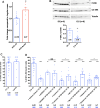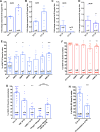Environmental and intrinsic modulations of venous differentiation
- PMID: 35987946
- PMCID: PMC11072674
- DOI: 10.1007/s00018-022-04470-4
Environmental and intrinsic modulations of venous differentiation
Abstract
Endothelial cells in veins differ in morphology, function and gene expression from those in arteries and lymphatics. Understanding how venous and arterial identities are induced during development is required to understand how arterio-venous malformations occur, and to improve the outcome of vein grafts in surgery by promoting arterialization of veins. To identify factors that promote venous endothelial cell fate in vivo, we isolated veins from quail embryos, at different developmental stages, that were grafted into the coelom of chick embryos. Endothelial cells migrated out from the grafted vein and their colonization of host veins and/or arteries was quantified. We show that venous fate is promoted by sympathetic vessel innervation at embryonic day 11. Removal of sympathetic innervation decreased vein colonization, while norepinephrine enhanced venous colonization. BMP treatment or inhibition of ERK enhanced venous fate, revealing environmental neurotransmitter and BMP signaling and intrinsic ERK inhibition as actors in venous fate acquisition. We also identify the BMP antagonist Noggin as a potent mediator of venous arterialization.
Keywords: Avian embryo; BMPs; ERK; Sympathetic pathway; Venous differentiation.
© 2022. The Author(s), under exclusive licence to Springer Nature Switzerland AG.
Conflict of interest statement
The authors declare no competing or financial interests.
Figures






Similar articles
-
Sympathetic Innervation Promotes Arterial Fate by Enhancing Endothelial ERK Activity.Circ Res. 2016 Aug 19;119(5):607-20. doi: 10.1161/CIRCRESAHA.116.308473. Epub 2016 Jun 27. Circ Res. 2016. PMID: 27354211
-
Plasticity of endothelial cells during arterial-venous differentiation in the avian embryo.Development. 2001 Sep;128(17):3359-70. doi: 10.1242/dev.128.17.3359. Development. 2001. PMID: 11546752
-
Differentiation of arterial and venous endothelial cells and vascular morphogenesis.Endothelium. 2006 Mar-Apr;13(2):137-45. doi: 10.1080/10623320600698078. Endothelium. 2006. PMID: 16728330 Review.
-
Vegf signaling promotes vascular endothelial differentiation by modulating etv2 expression.Dev Biol. 2017 Apr 15;424(2):147-161. doi: 10.1016/j.ydbio.2017.03.005. Epub 2017 Mar 7. Dev Biol. 2017. PMID: 28279709 Free PMC article.
-
Molecular identity of arteries, veins, and lymphatics.J Vasc Surg. 2019 Jan;69(1):253-262. doi: 10.1016/j.jvs.2018.06.195. Epub 2018 Aug 25. J Vasc Surg. 2019. PMID: 30154011 Free PMC article. Review.
Cited by
-
Mesenchymal Stromal Cells Facilitate Tip Cell Fusion Downstream of BMP-Mediated Venous Angiogenesis-Brief Report.Arterioscler Thromb Vasc Biol. 2023 Jul;43(7):e231-e237. doi: 10.1161/ATVBAHA.122.318622. Epub 2023 Apr 27. Arterioscler Thromb Vasc Biol. 2023. PMID: 37128914 Free PMC article.
References
-
- Kalucka J, de Rooij LPMH, Goveia J, Rohlenova K, Dumas SJ, Meta E, Conchinha NV, Taverna F, Teuwen LA, Veys K, et al. Single-cell transcriptome atlas of murine endothelial cells. Cell. 2020;180:764–779. - PubMed
-
- Vanlandewijck M, He L, Mäe MA, Andrae J, Ando K, Del Gaudio F, Nahar K, Lebouvier T, Laviña B, Gouveia L, et al. A molecular atlas of cell types and zonation in the brain vasculature. Nature. 2018;554:475–480. - PubMed
MeSH terms
Grants and funding
LinkOut - more resources
Full Text Sources
Miscellaneous

